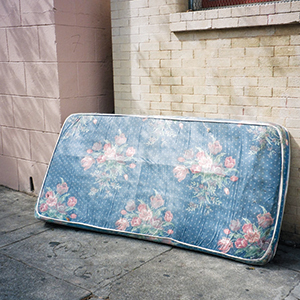Crudely simplified, the Chicano Art Movement advanced the aesthetic of rasquachismo, a defiant and inventive use of whatever lowbrow components one has on hand. It isn’t just cheap stuff for the sake of cheap stuff. There is a method of communication—something along the lines of: “This is all we got, so we’re going to use it.”
Translation: If one doesn’t have $1,000 for a deluxe convertible easel, one can plant cacti on the border between Tijuana and San Ysidro and carve them into Easter Island-style head profiles before transporting them to art-gallery pedestals, just to ridicule the highbrow colonization of the desert.
That said, at WORKS/San Jose, two cacti plants emerge from wooden pedestals colored with rainbow graffiti. It’s all part of “Chafismo: An Introduction to New Forms of Art Post-Rasquachismo,” a new exhibit curated by Angelica Muro and Hector Dionicio Mendoza.
Carved into facial profiles, the cacti look polished—almost ceramic—at first glance. Since they occupy the middle of the gallery, one starts to ask questions. Is this sculpture? Porcelain? Do they need water?
Instead of Marcel Duchamp’s urinal, single-handedly mainstreaming the ready-made aesthetic, Tijuana-based artist Rarotonga—named after an ’80s comic book character—tore into a few cacti and made them resemble border desert trinkets from some post-Catholic mass dystopia. Call it border Fluxus.
“Chafismo” is an open-ended term that comes from the word chafa, which literally means undervalued or refers to something worth more than it costs. Curators Muro and Mendoza have worked together for a long, long time. Both are veteran Latino artists, now affiliated with CSU Monterey Bay. Over the years, they became dismayed at how Latino or Chicano artists seemed pigeonholed, only getting exposure in Latino-specific galleries or once in a blue moon when a mainstream museum would deign to pay attention. They are sick of it all and they want to extend the boundaries. Hence “Chafismo.”
“It has a full spectrum of definitions, but we find that that word fits the current state of rasquachismo,” Muro says. “We are both Latino artists. And we really feel there needs to be a more contemporary and current dialogue moving the narrative forward.”
That might explain the non-heteronormative use of Loteria cards. The subjects depicted on these cards—social archetypes, like the drunkard, the hero and the devil, and common objects, like drums and bonnets—have been repurposed and remixed, ad nauseam, by Mexican artists for years. But one rarely sees Loteria-style illustrations exploring gay and lesbian issues. Felix D’eon harnesses the physical and emotional power of these iconic images to depict contemporary queer sensibility.
Monique Islam, on the other hand, threw a discarded mattress on the wall. It’s a large-scale photograph, not an actual mattress, but thanks to Islam, a degree of what poet Juan Felipe Herrera might call Chicano Zen creeps out from the image. Throughout several other photos in the show, Islam explores various themes including identity, family, home, and memory, emphasizing beauty in the everyday world or the unnoticed, overlooked aspects of existence.
In Capp Street Mattress, she presents an especially gorgeous contextualization. A mattress was discarded by society and sat leaning against a wall, along the street. Islam shot the photo, captured the image, and then hung it on a wall in the WORKS gallery. Was the original mattress leaning against a wall on the street an actual work of art in of itself? Or is it now only a work of art because it sits on a wall inside a gallery? Duchamp would be proud.
In another case, Arnaldo Vargas presents photographs of Wilmington, California, the only suburb on earth surrounded by nine oil refineries. In one shot, a Chevy Impala sits parked in a garage and we see the flare from the refinery in the background. In another, a skaterboarder busts a frontside boardslide at a skatepark backgrounded by cheap rental apartments and smokestacks.
Other artists in Chafismo utilize dirt-cheap elements of graphic design, installation, sculpture or prison cooking. Cut-rate items related to piñatas, lucha libre masks or Trump’s border wall fantasy likewise come into play. A new dimension of the Chicano Art Movement thus emerges. We truly live in the post-rasquachismo era.
Chafismo: An Introduction to New Forms of Art Post-Rasquachismo
Thru Mar 12, Free
WORKS/San Jose



